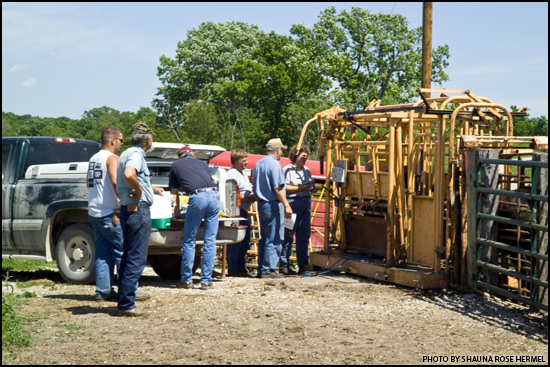HEALTH & NUTRITION...
BQA: A Way of Doing Business
From the proper way to clean a syringe to choosing the right needle to use for the animal in the chute, BQA guidelines help improve management efficiency while safeguarding consumer confidence.
These days, we're inundated with acronyms — so many that a body must pause and ponder the plethora of alphabet soup. But unless you're brand-spanking new to the beef cattle business, you probably know what "BQA" means. The industry put wheels under its beef quality assurance program more than 20 years ago, to help producers do a better job of raising, feeding and harvesting high-quality beef.
In the beginning, there may have been a few producers who scoffed at the notion. Maybe those folks figured they knew all that was needed about handling cattle and using the various products preventing or treating animal ailments, or for enhancing animal performance.
Here's a refresher with some vaccine handling tips to ensure greater effectiveness while safeguarding beef safety. Read more.
 How's Your Fridge Health?
How's Your Fridge Health?
The appearance of the refrigerator doesn't count, but how it functions may be critical if you store animal health products in it.
Believe it or not, your refrigerator could be one of the most important aspects of your animal health program. If you have more than one refrigerator, my guess is that your newer refrigerator is in your kitchen, while the older one is in the garage, mud room, porch, tack room, barn, etc. The one in your kitchen may have $75 worth of food, while the old clunker in the barn may have several hundred dollars of animal health products. The appearance of the refrigerator where you keep your animal health products is not important, but how it functions may be critical to your animal health program. Read more.

Bob Larson
Vet Link
Using vaccination to reduce disease risk
Use of appropriate vaccines in cattle herds is an important component of disease control; for some diseases it is nearly as important as proper nutrition and sanitation. Just as in human health, vaccines can play an important role in preventing some cattle diseases, but not others. And, for some diseases, vaccines play a supporting role compared to more important disease-control tools such as adequate nutrition, good sanitation and diagnostic testing. Read more.
Know Your Ear Rots Before Feeding Grain to Livestock
With several types of ear rot diseases appearing on this year's corn crop, properly identifying them is important for producers to make decisions about feeding grain to livestock.
"It is important to identify ear rot problems before harvest because some ear rot fungi produce mycotoxins that are harmful to livestock," says Pierce Paul, an Ohio State University (OSU) Extension plant pathologist with the Ohio Agricultural Research and Development Center (OARDC). "After harvest it becomes much more difficult to tell what's causing the problem."
Current weather conditions are favorable for ear rot development: wet weather late in the season, frost occurring before maturity, corn standing in the field for an extended period, and delayed maturity. Other indicators of potential ear rot problems include bird and insect damage, hybrid susceptibility and ears drying down in an upright position. Read more.

Rick Rasby
Ridin’ Herd
Plan now for winter feeding program.
As producers plan for their winter feeding program, a question that is frequently asked is, "How much will my cows eat on a daily basis?" Although there is no nutrient requirement for feed intake, knowing amounts that a cow consumes daily is essential in planning a winter feeding program, evaluating rations and supplements, and predicting animal performance. Closely estimating the amount of feed needed to get through the winter is important to contain costs. In addition, cattle have a certain requirement for specific nutrients such as protein, energy, and minerals and vitamins. The necessary concentration of the nutrients in the diet to meet the animals’ requirement is determined by the amount of feed consumed. Read more.
Weather Warning for Pneumonia
Pneumonia can affect calves of any age. Most of the bacterial pathogens that cause lung infections in calves older than newborns are already present — inhabitants of the calf's respiratory tract. They usually cause trouble only when immune defenses are compromised by stress, which can include bad weather or extreme changes in temperature. A primary viral infection [like IBR (infectious bovine rhinotracheitis) or one of the other respiratory viruses] can also damage the lining of the respiratory tract and allow the resident bacteria to move in. The bacterial pneumonia is more apt to kill the calf.
According to Robert Cope, veterinarian at Salmon, Idaho, for more than 35 years, weather stress is particularly dangerous when there are extremes of temperatures, such as in spring or fall, with hot days and cold nights.
"These pneumonia cases are almost always due to pasteurella and don't need a virus to get started. The key seems to be a temperature differential of 40° F to 50° F or more, such as 80°-90° afternoons in the fall dropping to 40° or lower at night, or 60° afternoons in the spring, dropping to 20° at night. With these conditions you often get some primary pasteurella infections. A virus respiratory vaccine won't protect calves in this situation, but a pasteurella vaccine might," Cope says.
— by Heather Smith Thomas
Mineral Program Can Boost
Conception Rates and Thwart Foot Rot
Tyler and Megan Galloway raise purebred and commercial cattle in New York. Two years ago they decided to use injectable minerals to try to boost conception rates to artificial insemination (AI).
"We gave all our virgin and first-calf heifers Multimin® when we gave prebreeding vaccinations, Tyler says. "We're always looking for ways to help first calvers breed back." The Galloways gate-cut the older cows and gave half of them injectable mineral as a test.
While this is a one-year field example, the Galloways seem to be pleased with the results. Tyler reports the highest percentage of first-service AI conception rates among first-calf females that he's ever obtained. "In our virgin heifers we had 83% first-service conception, whereas it had always been in the 70s before," he notes.
"We synchronize our virgin heifers to calve the last week in March," Tyler says. "We have a lot of snow in early spring, then it gets hot quickly. We want to calve in that short window of good weather. If we get even 5% to 10% more of them settled with first breeding, this helps," he says.
In the older cows, there was a notable difference in foot rot levels between those that did and those that didn't get the supplemental mineral, with less foot rot in the group that got the injection.
"Our climate is wet in spring, then hot and humid in summer, and we get foot rot in mid-summer," Tyler says. "After using Multimin that spring, we only had one cow with foot rot in that group, and she was one we bought." Five cows in the control group got foot rot. He says he feels it was more than coincidence that they had less foot rot in the cows that got the minerals.
— by Heather Smith Thomas
Cattle Diseases: Common Conditions/Terms
Click here for a list of common conditions and terms related to beef cattle diseases, such as anaplasmosis, brucellosis, BVD, E. coli, IBR and others.
[Click here to go to the top of the page.]





